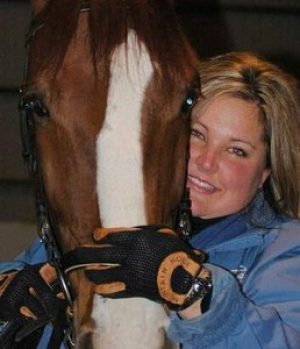From the factory floor to the racetrack floor: A rescue horse changes the life of an ‘exposure’ scientist
After earning her bachelor’s in animal science from MSU in 1995, Melissa Millerick-May, PhD (’08), began working as a toxicologist, industrial hygienist, and epidemiologist for an automotive supplier, studying the role of indoor air-quality contaminants in the development of lung disease in workers. This scientist of air quality and lung disease—and lifelong horse lover—rescued a horse that would ultimately change the course of her career. The horse had been diagnosed with heaves—a chronic and potentially life-threatening lung disease.
“Professionally, I was trained to evaluate indoor and outdoor air quality and determine whether contaminants were present with the potential to negatively affect airway health. From there, the focus would be to reduce and possibly eliminate further exposures to workers and/or surrounding communities.” Millerick-May says. “With humans, we have guidelines such as occupational exposure limits and air quality standards to compare concentrations of contaminants – below which it is anticipated that there is likely to be no adverse effect. As a result of what I’d learned about heaves in horses, and understanding the need to reduce or eliminate adverse exposures, I started looking into the literature to see if anything similar existed for the horse.”

Millerick-May grew frustrated with the lack of available information pertaining to airborne contaminants and exposures of concern in horses. She prefers to prevent exposures to the contaminant(s) responsible for disease, rather than to rely on medications after the development of clinical signs. Her veterinarian recommended she talk to “the guru of airway disease in horses—Ed Robinson.”
Millerick-May emailed Robinson. Three hours later, he responded. Now, more than a decade later, Millerick-May still can quote the email from memory.
“It said–I’ll never forget this—‘Melissa, a serendipitous event has occurred. We know how to measure airway inflammation and disease in horses but we’re not set up to measure environment. You know how to measure environment. You need to come see us.’ So I did just that.”
She met with Drs. Robinson, Susan Holcombe and Frederik Derksen; the three recently had finished a study at Thistledown Racetrack in Ohio and wanted to measure indoor air quality in racing stables and see if there was an association with indices of airway inflammation. Millerick-May was just finishing a master’s degree in occupational and environmental health sciences. Robinson invited her to apply to the MSU PhD program in Comparative Medicine and Integrative Biology.
At the time, Millerick-May was a member of a joint committee studying worker health in the automotive industry, and her boss was encouraging her to pursue a PhD. Horses are one of few natural animal models for human airway disease, and the program aligned with Millerick-May’s career aspirations.
“I’m so fortunate to have been introduced to Dr. Robinson because he allowed me to take something I’ve been professionally trained to do and apply it to something I’m personally passionate about,” she says.
After beginning her doctoral studies, she Millerick-May began a two-year study at Thistledown racetrack, monitoring air quality in stables and evaluating horses for tracheal mucus and inflammatory cells. The study found that horses living in stables with elevated particle concentrations had a greater risk for airway inflammation.
“We evaluated exposures known to play a role in human airway disease, and looked to see if things like how buildings (stables) are constructed, ventilation, practices such as feeding and cleaning played a role in indoor air quality” she says. The team concluded that indeed these variables and proximity to roadways were key factors in indoor air quality and as a result, horses’ lung health.
In 2008, she joined the faculty in the MSU Department of Medicine, Division of Occupational and Environmental Medicine. She has continued to work with Robinson, writing joint papers, grant proposals, and consulting on protocols with his graduate students.
Robinson, she says, “is a wonderful teacher and, I am fortunate to say, mentor and friend.
“I’ve been done now for six years and while we don’t work together on a daily basis, he remains a tremendous influence and mentor,” she adds. “I haven’t met anyone that knows Dr. Robinson that doesn’t have a list of wonderful things to say about him, regardless of how they know him—whether it be as a teacher, colleague, mentor, or friend. It really takes a special person to have that kind of influence over that many people.”
Posted: May 2014
Contact: Casey Williamson
